The DOJ mandates on Boeing look to designed for FRAUD not SAFETY
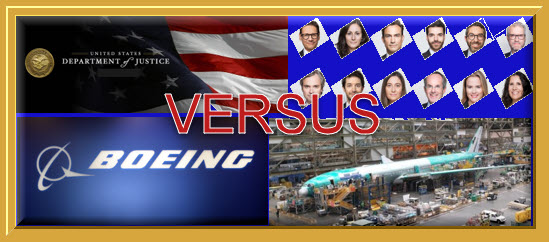
The disastrous Boeing Max 8 has resulted in a number of articles and a rash of Congressional Hearings which focused on the COMPANY’S INADEQUATE ATTENTION TO DETAIL IN THE DESIGN AND MANUFACTURING OF THIS PLANE, as well as APT CRITICISM OF ITS DEALING WITH THE FAA.
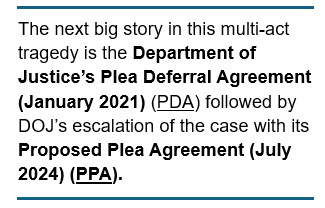
The media has generally highlighted the charges made by the victims’ counsel, repeated the horror stories of all the whistleblowers PLUS made headlines of the FAA’s repeated audits. From this voluminous collection of failed safety failures and based on the Statements of almost every Member of Congress, ONE WOULD EXPECT THAT ANY CRIMINAL SANCTION WOULD TARGET IMPROVING BOEING’S SAFETY CULTURE, their adherence to airworthiness in all that it does, the inculcation of a constant 3600 awareness of attacking risk, etc.
DOJ has set forth its terms for Boeing’s probation in three documents
- An Update (2,006 words)
- GOVERNMENT STATUS REPORT AND PROPOSED PLEA AGREEMENT (33 pages ~9,900 words) (PPA)
- ATTACHMENTS-A-F (36 pages ~ 10,800 words) (part of PPA)
Focusing on the DOJ’s proposed Independent Compliance Monitor (ICM), a title comparable to Part 5’s Accountable Executive, such a function could easily provide the safety guidance, which one would surmise has been absent in Renton and North Charleston, and should be well situated to drive a SAFETY CULTURE into this aircraft manufacturer.
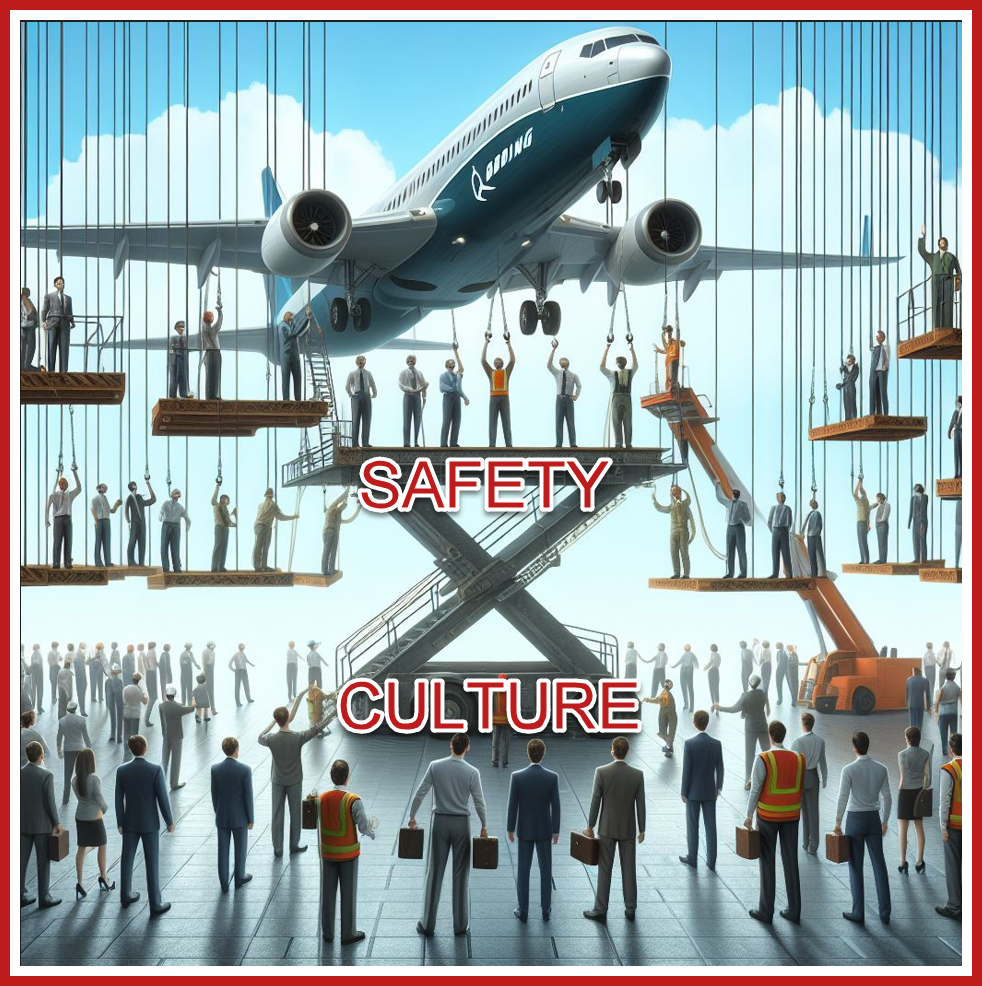
Creating an ICM/AE would have had the technical expertise to challenge Boeing’s deficient practices, policies and procedures. She/He would be able to counsel Boeing’s Board what really needs to be done to correct the situation– such advice would have been based on extensive real world experience in establishing SAFETY as the company’s DNA. Such a voice would be heard both by the senior ranks of the aerospace company but would ring true on the hangar production lines. Clearly, past management-worker relationships lacked trust. Absent that bond SMS will not likely effectively identify risk early in design, testing or manufacturing. Such a qualified SME would be able to help the organization, once more top-to-bottom and the reverse, agree to practices that would foster collaboration!!!
Justice, perhaps based on the specific criminal laws cited, upon, or out-of-an-abundance of caution to avoid replication the FAA’s authority, choose to direct the ICM to
“31. The Independent Compliance Monitor candidates and their team members shall have at a minimum, the following qualifications (additional preferred qualifications will be articulated in the posting):
a. demonstrated expertise with respect to U.S. FRAUD LAWS, including experience counseling on anti-fraud compliance issues;
b. previous service as an independent compliance monitor or other substantial demonstrated experience designing, evaluating, or administrating CORPORATE COMPLIANCE PROGRAMS AND INTERNAL CONTROLS, including ANTI-FRAUD POLICIES, PROCEDURES, AND INTERNAL CONTROLS, for a publicly traded company;
c. the ability to access and deploy resources as necessary to discharge the Independent Compliance Monitor’s duties as described in the Agreement; and
d. sufficient independence from the Defendant, its competitors, and any individuals involved in a safety incident involving the Defendant, among others, to ensure effective and impartial performance of the Independent Compliance Monitor’s duties as described in the Agreement.”
The indictment found that Boeing committed fraud by misrepresenting and/or withholding information submitted to the FAA AIRWORTHINESS AUTHORITY. The significant consequence of these bad acts was to obtain an FAA Certificate of Airworthiness and thus to have put the traveling public at risk—TRAGICALLY THAT DID HAPPEN.
Attachment C only makes three references to safety, 5 times risk , risk assessment or risk management mentioned with regard to fraud–no mention of FAA, FAR, aircraft design, airworthiness, responsible executive, 14 CFR
IT IS NOT CLEAR HOW A FRAUD EXPERT CAN DETECT THAT THE TECHNICAL DATA TO BE SUBMITTED WOULD BE INACCURATE?
The PPA, page 29, states that the Defendant will RETAIN (pay for? Retain is a term that frequently refers to hire for counsel?) the ICM (see also paragraph 36). To clear that ambiguity up, Attachment D Paragraph 7 states that no Attorney Client relationship between the ICM and Boeing shall exist.
Oh, by the way, Boeing, paragraph 33,“the opportunity to strike one (1) of the six (6) candidates from the final pool identified by the Offices…”
WHAT IS THE ICM’S MANDATE?
Paragraph 3 of Attachment D indicates that the ICM will “evaluate, in the manner set forth below, the effectiveness of the Company’s compliance program and INTERNAL CONTROLS, RECORD-KEEPING, POLICIES, AND PROCEDURES as they relate to the Company’s current and ongoing COMPLIANCE WITH U.S. FRAUD LAWS, PARTICULARLY IN CONNECTION WITH INTERACTIONS WITH ANY DOMESTIC OR FOREIGN GOVERNMENT AGENCY.”
Paragraph 8 of Attachment D adds that the ICM “may rely on the product of the company’s processes, such as the results of studies, reviews, sampling and testing methodologies, audits, and analyses conducted by or on behalf of the Company, as well as the Company’s INTERNAL RESOURCES (E.G., LEGAL, COMPLIANCE, AND INTERNAL AUDIT), which can assist the Independent Compliance Monitor in carrying out the Mandate through increased efficiency and Company-specific expertise, provided that the Independent Compliance Monitor has confidence in the quality of those resources.”
Paragraph 10 of Attachment D muddles what can/should be done with this, “The Independent Compliance Monitor’s reviews should use a risk-based approach…In carrying out the Mandate, the Independent Compliance Monitor should consider, for instance, RISKS PRESENTED BY: (A) THE INDUSTRIES IN WHICH THE COMPANY OPERATES; (B) BUSINESS INTERACTIONS WITH GOVERNMENT OFFICIALS, INCLUDING THE AMOUNT OF GOVERNMENT REGULATION AND OVERSIGHT OF THE COMPANY IN CONDUCTING ITS BUSINESS AFFAIRS—but note, as stated in Paragraph 4 above, that THE MANDATE DOES NOT INCLUDE REVIEW OF THE CORRECTNESS OF ANY OF THE COMPANY’S DECISIONS RELATING TO COMPLIANCE WITH THE FAA’S REGULATORY REGIME…”
Paragraph 4 of Attachment D adds further confusion by specifying “The Independent Compliance Monitor’s Mandate IS NOT INTENDED TO SUPPLANT THE OVERSIGHT AUTHORITY OF THE FEDERAL AVIATION ADMINISTRATION (FAA)—or that of any pertinent foreign aviation regulator, e.g., the European Union Aviation Safety Agency—including over matters related to design, engineering, manufacturing, and safety. The same is true as to the authority of the National Transportation Safety Board (“NTSB”). As a result, the Independent Compliance Monitor’s Mandate does not include substantive review of the Company’s design, engineering, or manufacturing processes and decisions, or of the correctness of any of the Company’s decisions relating to compliance with the FAA’s regulatory regime.”
- Paragraph 30 of Attachment D, entitled “Confidentiality of Independent Compliance Monitor’s Reports” has significant caveats about disclosure similar to the FAA’s ASAP and unions have cautioned their members from trusting the immunity. BAD for Boeing Safety
- Same paragraph- likely that the plaintiffs will vigorously seek information that may be damaging to Boeing. This threat could limit the ICM’s access and harm Boeing’s SMS
The ICM’s authority is confusing. Putting the following CRITICAL SAFETY PROCESSES AT RISK:
- The ICM’s ability to examine Boeing’s existing library of employee submissions under SMS is sufficiently imprecise as to possibly discourage employees from participating.
- Frank conversations among the Safety Review team may be deterred by the ICM’s potential review and use of these risk evaluation information.
- The establishment of the authority and credibility of the Boeing Accountable Executive (hopefully the new CEO will take follow his predecessors and assume this responsibility) will be harmed so long as the ambiguity of which person is appropriate individual for flagging safety issues—ICM or AE? Reestablishing a vigorous safety culture BEGINS with an effective AE.
- If the AE learns of a problem, what obligation is there to inform the ICM? More critically, if the ICM learns of a risk, it would appear important to disclose to the AE immediately; SO THAT BOEING CAN QUICKLY ADDRESS THE PROBLEM?
Mixing FRAUD compliance with SAFETY COMPLIANCE may negatively impact precisely the risk management system that Boeing MUST install. Better integration and clearer mandate should be included before it becomes mandatory.
United States v. The Boeing Company

The Boeing Company
Deferred Prosecution Agreement (DPA)
Court Docket No.: 4:21-CR-005-O (N.D. Texas)

On July 24, 2024, the U.S. Department of Justice (the “Department” or “Government”) filed with the United States District Court for the Northern District of Texas (the “Court”) the proposed plea agreement with The Boeing Company (“Boeing”)…
========================
UNITED STATES DISTRICT COURT FOR THE
NORTHERN DISTRICT OF TEXAS
Fort Worth Division
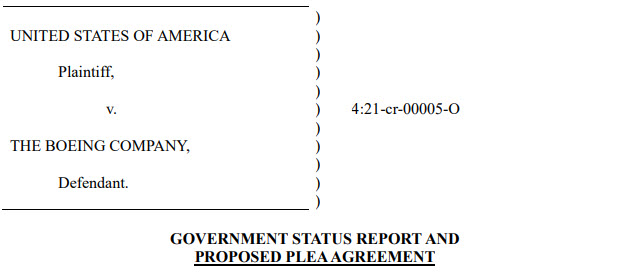
THEN p.3-4…
Retention of Independent Compliance Monitor.
A condition of probation shall be that Boeing retain an INDEPENDENT COMPLIANCE MONITOR. The Independent Compliance Monitor’s selection process, mandate, duties, review, and certification are described in the plea agreement and Attachment D to the plea agreement. The Government will select and oversee the Independent Compliance Monitor. With respect to selection, the Government will post on its public website a REQUEST FOR PROPOSALS from potential monitor candidates, and, WITH FEEDBACK FROM BOEING, select a candidate that meets the specific qualifications articulated in the public posting and the general qualifications articulated in the Criminal Division’s Revised Memorandum on Selection of Monitors in Criminal Division Matters. The Government will notify the Court under seal of its intent to select a certain candidate; and if, after 10 days, the Court does not raise concerns, the Government will finalize the selection and appoint the monitor. The monitor will prepare a confidential annual report for the Government, and file on the public court docket an executive summary of that annual report.
,,,
Proposed Pleas Agreement
p.23-27
Independent Compliance Monitor
29. Promptly after the Offices’ selection pursuant to Paragraph 35 below, the Defendant agrees to RETAIN an Independent Compliance Monitor for the Term specified in Paragraph 14[1]. The Independent Compliance Monitor’s duties and authority, and 30. On the date this Agreement is accepted by the Court, the Offices will solicit applications for Independent Compliance Monitor candidates on its public website. Independent Compliance Monitor candidates shall have fourteen (14) days after the publication of the solicitation to submit a written application to the Offices, providing, at a minimum, the following:
a. a description of the candidate’s qualifications and credentials in support of the evaluative considerations and factors listed below;
b. proposed members of the monitorship team and their qualifications and credentials in support of the minimum requirements listed below;
c. proposed methodology for testing and review to carry out the Independent Compliance Monitor’s mandate as articulated in Attachment D;
…
31. The Independent Compliance Monitor candidates and their team members shall have at a minimum, the following qualifications (additional preferred qualifications will be articulated in the posting):
a. demonstrated expertise with respect to U.S. FRAUD LAWS, including experience counseling on anti-fraud compliance issues;
b. previous service as an independent compliance monitor or other substantial demonstrated experience designing, evaluating, or administrating CORPORATE COMPLIANCE PROGRAMS AND INTERNAL CONTROLS, including ANTI-FRAUD POLICIES, PROCEDURES, AND INTERNAL CONTROLS, for a publicly traded company;
c. the ability to access and deploy resources as necessary to discharge the Independent Compliance Monitor’s duties as described in the Agreement; and
d. sufficient independence from the Defendant, its competitors, and any individuals involved in a safety incident involving the Defendant, among others, to ensure effective and impartial performance of the Independent Compliance Monitor’s duties as described in the Agreement.
32. The Offices shall select six (6) candidates that meet the requirements in Paragraphs 30 and 31 above. Each of the six candidates will meet with the Defendant, and the Offices would then solicit feedback from the candidates and the Defendant. If the Defendant believes in good faith that any of the six candidates do not meet the requirements…
33. The Defendant shall have the opportunity to strike one (1) of the six (6) candidates from the final pool identified by the Offices…
…
36. The Independent Compliance Monitor’s term shall be three years from the date on which the Independent Compliance Monitor is RETAINED BY THE DEFENDANT, subject to extension or early termination as described in Paragraph 14. 37. The Independent Compliance Monitor’s powers, duties, and responsibilities, as well as additional circumstances that may support an extension of the Independent Compliance Monitor’s term, are set forth in Attachment D. …
Another 10 pages of restrictions on Boeing during the term of the Agreement
ATTACHMENT A-1
FACTUAL BASIS FOR BREACH
8 pages of description of Boeing’s violations of the previous deferred plea agreement
ATTACHMENT A-2
STATEMENT OF FACTS
15 pages of incredibly, detailed, regulatory astute and precise statement of Boeing’s conspiracy to defraud the FAA certification
ATTACHMENT C
CORPORATE COMPLIANCE PROGRAM
8 pages defining a COMPLIANCE PROGRAM
focused on fraud
only three references to safety, 5 times risk , risk assessment or risk management mentioned with regard to fraud–no mention of FAA, FAR, aircraft design, airworthiness, responsible executive, 14 CFR
a fraud compliance program to be monitored by Boeing
ATTACHMENT D
INDEPENDENT COMPLIANCE MONITOR
p. D-1—14
…
1. It shall be a special condition of probation that the Company RETAIN the Independent Compliance Monitor. However, it is not a condition of probation that the COURT OVERSEE THE Independent Compliance Monitor. RATHER, THE INDEPENDENT COMPLIANCE MONITOR WILL REPORT TO AND BE OVERSEEN BY THE OFFICES…
2. The Company will retain the Independent Compliance Monitor for a period of three years…
Independent Compliance Monitor’s Mandate
3. The Independent Compliance Monitor’s primary responsibility is to assess and monitor the Company’s compliance with Paragraph 7(k) of the Agreement, including the Corporate Compliance Program in Attachment C, as necessary to address and reduce the risk of any recurrence of the Company’s misconduct…During the Term of the Monitorship, the Independent Compliance Monitor will evaluate, in the manner set forth below, the effectiveness of the Company’s compliance program and INTERNAL CONTROLS, RECORD-KEEPING, POLICIES, AND PROCEDURES as they relate to the Company’s current and ongoing COMPLIANCE WITH U.S. FRAUD LAWS, PARTICULARLY IN CONNECTION WITH INTERACTIONS WITH ANY DOMESTIC OR FOREIGN GOVERNMENT AGENCY, with a focus on the integration of its compliance program with its safety and quality programs as necessary to detect and deter violations of anti-fraud laws or policies, and take such reasonable steps as, in his or her view, may be necessary to fulfill the foregoing mandate (the “Mandate”). This Mandate SHALL INCLUDE AN ASSESSMENT OF THE BOARD OF DIRECTORS’ AND SENIOR MANAGEMENT’S COMMITMENT TO, AND EFFECTIVE IMPLEMENTATION OF, THE CORPORATE COMPLIANCE PROGRAM
4. The Independent Compliance Monitor’s Mandate IS NOT INTENDED TO SUPPLANT THE OVERSIGHT AUTHORITY OF THE FEDERAL AVIATION ADMINISTRATION (FAA)—or that of any pertinent foreign aviation regulator, e.g., the European Union Aviation Safety Agency—including over matters related to design, engineering, manufacturing, and safety. The same is true as to the authority of the National Transportation Safety Board (“NTSB”). As a result, the Independent Compliance Monitor’s Mandate does not include substantive review of the Company’s design, engineering, or manufacturing processes and decisions, or of the correctness of any of the Company’s decisions relating to compliance with the FAA’s regulatory regime.
Company’s Obligations
5. The Company shall COOPERATE FULLY with the Independent Compliance Monitor, and the Independent Compliance Monitor shall have the authority to take such reasonable steps as, in his or her view, MAY BE NECESSARY TO BE FULLY INFORMED ABOUT THE COMPANY’S COMPLIANCE PROGRAM in accordance with the principles set forth herein and subject to applicable law, including applicable data protection and labor laws and regulations. To that end, the Company shall: facilitate the Independent Compliance Monitor’s ACCESS TO THE COMPANY’S DOCUMENTS AND RESOURCES; NOT LIMIT SUCH ACCESS, except as provided in Paragraphs 7-8; and provide guidance on applicable local law (such as relevant data protection and labor laws). The Company shall PROVIDE THE INDEPENDENT COMPLIANCE MONITOR WITH ACCESS TO ALL INFORMATION, DOCUMENTS, RECORDS, FACILITIES, AND EMPLOYEES, as …Fees and costs associated with the Monitorship shall be expressly unallowable costs for government contract accounting purposes.
6. Any disclosure by the Company to the Independent Compliance Monitor concerning evidence or allegations of violations of U.S. fraud laws shall not relieve the Company of any otherwise applicable obligation to truthfully disclose such matters to the Offices, pursuant to the Agreement. Notwithstanding any other provision of this Attachment D, the Company shall retain its attorney-client privilege and work-product protections and in no event shall be required to waive its attorney-client privilege.
Withholding Access
7. The parties agree THAT NO ATTORNEY-CLIENT RELATIONSHIP SHALL BE FORMED BETWEEN THE COMPANY AND THE INDEPENDENT COMPLIANCE MONITOR. …
8. If the matter cannot be resolved, at the request of the Independent Compliance Monitor, the Company shall promptly provide written notice to the Independent Compliance Monitor and the Offices…
9. In carrying out the Mandate, to the extent appropriate under the circumstances, the Independent Compliance Monitor should COORDINATE WITH COMPANY PERSONNEL, INCLUDING IN-HOUSE COUNSEL, COMPLIANCE PERSONNEL, AND INTERNAL AUDITORS, ON AN ONGOING BASIS. The Independent Compliance MONITOR MAY RELY ON THE PRODUCT OF THE COMPANY’S PROCESSES, SUCH AS THE RESULTS OF STUDIES, REVIEWS, SAMPLING AND TESTING METHODOLOGIES, AUDITS, AND ANALYSES CONDUCTED BY OR ON BEHALF OF THE Company, as well as the Company’s INTERNAL RESOURCES (E.G., LEGAL, COMPLIANCE, AND INTERNAL AUDIT), which can assist the Independent Compliance Monitor in carrying out the Mandate through increased efficiency and Company-specific expertise, provided that the Independent Compliance Monitor has confidence in the quality of those resources.
10. The Independent Compliance Monitor’s reviews should use a risk-based approach, and thus, the Independent Compliance Monitor is not expected to conduct a comprehensive review of all business lines, all business activities, or all markets. In carrying out the Mandate, the Independent Compliance Monitor should consider, for instance, RISKS PRESENTED BY: (A) THE INDUSTRIES IN WHICH THE COMPANY OPERATES; (B) BUSINESS INTERACTIONS WITH GOVERNMENT OFFICIALS, INCLUDING THE AMOUNT OF GOVERNMENT REGULATION AND OVERSIGHT OF THE COMPANY IN CONDUCTING ITS BUSINESS AFFAIRS—but note, as stated in Paragraph 4 above, that THE MANDATE DOES NOT INCLUDE REVIEW OF THE CORRECTNESS OF ANY OF THE COMPANY’S DECISIONS RELATING TO COMPLIANCE WITH THE FAA’S REGULATORY REGIME…
11. In undertaking the reviews to carry out the Mandate, the Independent Compliance Monitor shall formulate conclusions based on, among other things: (A) INSPECTION OF RELEVANT DOCUMENTS, INCLUDING THE COMPANY’S CURRENT policies and procedures governing compliance with U.S. FRAUD LAWS; (b) ON-SITE OBSERVATION OF SELECTED SYSTEMS AND PROCEDURES OF THE COMPANY AT SAMPLE SITES, INCLUDING INTERNAL ACCOUNTING CONTROLS, RECORD-KEEPING, AND INTERNAL AUDIT PROCEDURES; (c) meetings with, and interviews of, relevant current and, where appropriate, former directors, officers, employees, business partners, agents, and other persons at mutually convenient times and places; and (d) ANALYSES, STUDIES, AND TESTING OF THE COMPANY’S COMPLIANCE PROGRAM. Independent Compliance Monitor’s Written Work Plans
12. To carry out the Mandate, during the Term of the Monitorship, the Independent Compliance Monitor shall conduct AN INITIAL (“FIRST”) REVIEW AND PREPARE A FIRST REPORT, FOLLOWED BY AT LEAST TWO FOLLOW-UP REVIEWS and reports as described in Paragraphs 19-26 below. With respect to the first report, after consultation with the Company and the Offices, the Independent Compliance Monitor shall prepare THE FIRST WRITTEN WORK PLAN WITHIN SIXTY (60) CALENDAR DAYS OF BEING RETAINED, and the COMPANY AND THE OFFICES SHALL PROVIDE COMMENTS WITHIN THIRTY (30) CALENDAR DAYS after receipt of the written work plan…
13. The first review shall commence no later than one hundred twenty (120) calendar days from the date of the engagement of the Independent Compliance Monitor (unless otherwise agreed by the Company, the Independent Compliance Monitor, and the Offices)…
p. D-8—13 more procedural requirements—
Confidentiality of Independent Compliance Monitor’s Reports
30. The Independent Compliance Monitor’s reports will likely include proprietary, financial, confidential, and competitive business information. Moreover, public disclosure of the {specific list of} reports could DISCOURAGE COOPERATION OR IMPEDE PENDING OR POTENTIAL GOVERNMENT INVESTIGATIONS and thus undermine the objectives of the Monitorship. For these reasons, among others, the reports and the contents thereof are INTENDED TO REMAIN AND SHALL REMAIN NON-PUBLIC, EXCEPT AS OTHERWISE AGREED TO BY THE PARTIES IN WRITING, OR EXCEPT TO THE EXTENT THAT THE OFFICES DETERMINE IN THEIR SOLE DISCRETION THAT DISCLOSURE would be in furtherance of the Offices’ discharge of their duties and responsibilities or is otherwise required by law…
ATTACHMENT E
CERTIFICATION
ATTACHMENT F
COMPLIANCE CERTIFICATION
More technical requirements
And signature block
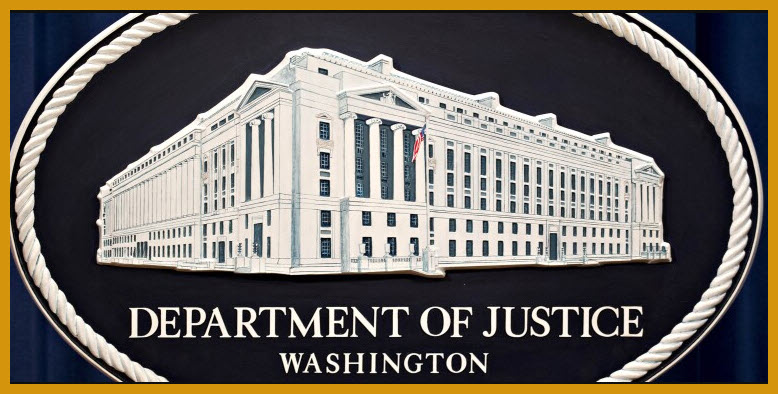
[1] Defendant’s obligations under the Agreement shall be effective for a period beginning on the date on which this Agreement is entered and ending three years from the later of the date on which this Agreement is entered or the date on which the Independent Compliance Monitor is retained by the Defendant, as described in Paragraphs 29-37 below (the “Term”). The Defendant agrees, however, that in the event the Offices determine, in their sole discretion, that the Defendant has knowingly violated any provision of this Agreement or failed to completely perform or fulfill each of the Defendant’s obligations under this Agreement, the Offices, in their sole discretion, may impose an extension or extensions of the Term for up to a total additional time period of one year,